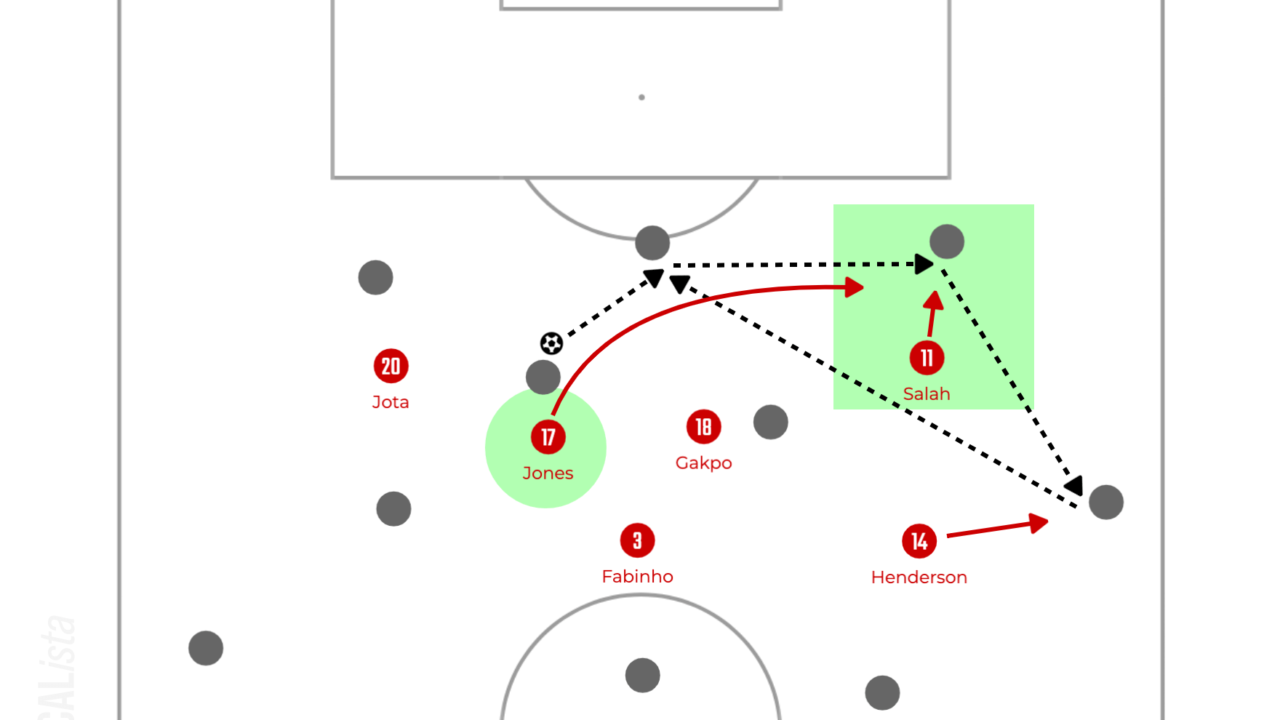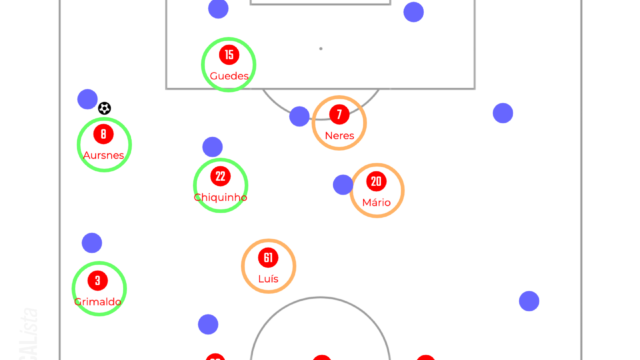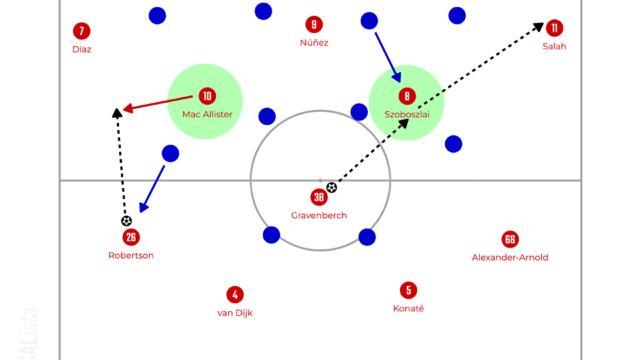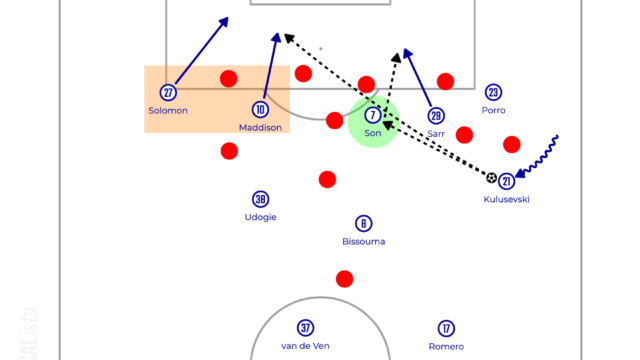Liverpool FC Tactical Analysis 22-23 [How Trent Alexander-Arnold in Midfield Benefits?]

Introduction
It was a tough season for Liverpool. Last season, they almost won every single trophy with reaching all finals, which means they played the possible maximum number of games in a season. Of course, the accumulated fatigue from last season could be a reason for their worse performance than it was expected, but it is difficult to know that. However, the last two months were not bad for them and secured the European place, although it is UEFA Europa League. The turning point could be the moment when converting Trent Alexander-Arnold to the pivot clearly in possession. He is a specialist who has exceptional strengths and clear weaknesses. In this article, therefore, how this transformation influenced Liverpool’s better performance at the end of the season and also the possibility that it has not affect the improvement of performance will be discussed.
In Possession
How Alexander-Arnold in the midfield worked is the main topic of this article. In possession, he steps up into the midfield next to Fabinho and the whole system looks like a 3-2-2-3 with Alisson Becker in goal. To be fair, Alexander-Arnold often comes inside before, but the difference is that he was fixed in the midfield now. In other words, it became more static than before especially in the right side. In the previous few years, the triangle formed by Alexander-Arnold, Mohamed Salah and Jordan Henderson in the right side had been flexible. However, being flexible means that it is difficult to prepare for defensive transitions with a solid structure. Thus, it may be possible to say that to fix Alexander-Arnold next to Fabinho is one of the managements in transitions.
Then, detail tactics of playing out from the back and attacking in the final third will be analysed.
Build up
Liverpool is willing to play long with accepting a risk of losing the ball because they know they can regain it quickly and this is what Jürgen Klopp wants. Both Alisson and Virgil van Dijk are excelled at playing long in behind and both Salah and Luis Díaz can run past the opposition fullbacks. If successfully the ball is played over the opposition defenders and one of the wingers can receive it, it would be scored. It is done. However, even though they have world class players who can play over or run in behind, most of all long balls are unsuccessful, or headed by one of the opposition defenders. Then, the next situation is fighting the second ball and the change of the system helps it. Thanks to Alexander-Arnold stepping up to the midfield, Henderson does not need to drop back to help Fabinho. Therefore, his job is drifting wide to receive the ball in between the lines or, more importantly, securing the second ball after Salah and his marker fought for the first contact.

Not only Henderson but also the striker Cody Gakpo often initially drops deeper and follows the long ball to get the second ball. After regaining the second ball, they will play fast attacks and threaten the goal.
This is the typical Liverpool’s build up, but of course not every time they play long and actually they usually start to play on the ground to find a spare player in between the lines safely. In this case, both wingers and Curtis Jones are the important players. When the opposition team presses high, it is difficult to receive the ball and turn successfully. Therefore, it is vital for players who try to receive the ball from the back to have an ability to hold it and lay it off.

The illustration above shows one of the chances against Spurs from the build up (Sorry it’s Harvey Elliott, not Henderson). Díaz comes inside to receive the ball while being marked by the opposition defender from his back. As he receives the ball, the opposition players around him were drawn to him, leaving the space for Alexander-Arnold to receive the ball from Díaz and carry it forward. Thanks to the ability of Díaz, Salah or Jones to keep the ball under the pressure helps the build up against high pressing so much.
Overall, the objective of build up for Liverpool is to break the opposition high back line rather than keeping the ball to progress step by step. Therefore, they are willing to play long and the structure of regaining the second balls is organised well and helped by the conversion of Alexander-Arnold into the pivot.
Final Third Attacking
Before analysing the detail of the final third attacking, the basic system is going to be explained.

From the original positions of the 3-2-5, most of all players except for the centre backs are given a degree of freedom. In the left flank, the triangle of Andrew Robertson, Díaz and Jones is extremely flexible. Díaz can play both inside and outside of the opposition defensive block and Robertson will help him by overlapping or underlapping. Additionally, Jones can drop back to create a passing lane from the back and also let Robertson move higher. On the other hand, as it was mentioned, the triangle is not as flexible as it was. Alexander-Arnold tends to stay in front of the opposition midfield line, and Henderson and Salah swap each position frequently. Instead of moving so much, Alexander-Arnold stay in the middle and works with Fabinho. His strength is not only the distribution. His ability to receive the ball and turn forward between the opposition players makes it possible for him to play in the middle.
However, playing through the middle is not the first option for them. Gakpo often tries to drop back to create a passing lane in the middle, but he is struggling to play in a tight area with facing backwards, so it is not working well so far. As a result, Liverpool’s final third attacking is usually from one side to the other and they hope something special to break the opposition defensive block down. But hopefully, they have players who can do something special.
Especially, in the right side, there are one of the best wingers and crossers in the world.

In order to help Salah to dribble inside, Henderson often makes a movement of overlapping or underlapping to drag the opposition defenders around Salah towards the goal line with leaving the space at the edge of the box. The space can be exploited by Salah, but Alexander-Arnold can also effectively play there. The out-swing crosses from there towards the back post is one of his weapons and it is often Jones to arrive at the back post.
As Liverpool love counterattacks or fast attacks from building up, the tactics in these transitional situations should be also mentioned here.

This is the second goal against Leeds United. The right winger Diogo Jota won the ball in the midfield and carried the ball forward, then Salah struck the ball towards the near side of the net. The key is the movement of Salah. Both Salah and Gakpo were in the right side, but as soon as Jota started to carry the ball forward, Salah ran towards the left side to give him options to both sides of him. This is extremely important because the opposition defenders cannot predict which the ball will be played. Additionally, as Salah did in this case, diagonal runs can cause problems in the opposition defenders. They would think if swapping the mark or not, or keeping the line or prioritising to mark the attackers. Therefore, it is possible to say that they score goals from the open situation thanks to not only their athletic ability but also the structure helping them.
Out of Possession
The aggressive pressing has been the trademark of Klopp’s Liverpool. However, due to the lack of ‘intensity’ this season and also the opposition improvement of building up, the pressing has been frequently bypassed. One of the main reasons is that their pressing relies on individual efforts rather than the system, although this is similar to their tactics of final third attacking. Klopp encourages his own players to maximise their strength, but in other words, he hardly helps them by systems.
Pressing
Their basic structure when pressing high in static situations like the opposition goal kicks is setting a 4-3-1-2 with wingers positioning themselves higher than the striker or sometimes a 3-2-3-2 with Alexander-Arnold stepping up. Then, the first player to apply pressure on the ball as soon as the opposition goalkeeper plays to one of the opposition centre backs is often one of the wingers.

The arced pressing from the outside to inside with cutting the passing lane to the opposition fullback will force the opposition centre back to play back to the goalkeeper, but Salah in the illustration will not stop running and keep pressing on the ball. As a result, the goalkeeper will play long and the transitional situation after that is favourable for Liverpool.
As it was mentioned, Liverpool do not to stick to a system. Therefore, if the striker is closer to the ball, he will press to the opposition player on the ball instead of the wingers especially in open plays. Additionally, the more important thing is the phrase of ‘Salah will not stop running’.
The intensity comes from the effort of keeping applying pressure on the ball by pressing one more. Not only just pressing to the opposition player in front, but Klopp’s players will also continue their pressing after the ball is played short to the other opposition player.

This is the example when their pressing was bypassed and Arsenal scored the first one at Anfield. Jones stepped up as soon as the opposition defensive midfielder received the ball and kept applying pressure after he played back and even the middle centre back played to the other centre back. However, the left centre back was also pressed by Salah. Therefore, it was a 2v1 situation. This looks an advantage for Liverpool, but in other words, there is a spare player and Arsenal could find him. Keeping running looks intense, but in this case, Jones was just forced to run unnecessarily.
Another weakness is, as it is expected, the right side where Alexander-Arnold and Ibrahima Konaté are defending. Especially, Alexander-Arnold’s awareness of the opposition left winger being ready for running in behind is poor and often being run past easily. Additionally, Konaté is also often dragged out by marking too tightly the opposition striker dropping back, so the space behind them is so easy to exploit for the opposition team.

As their pressing, which is Liverpool’s identity, has not worked well throughout the season, it is obvious they need to rebuild this area by improving their fitness level or tactics this upcoming preseason because the pressing is everything for them.
Conclusion
As their tactics are based on individual performance, the success and failure can be easily attributed to their players. Therefore, as they let Sadio Mané leave or Darwin Núñez and Gakpo replace Roberto Firmino, this season should have been a tough season for them. It was the time to rebuild the squad. However, it was just worse than we had expected. Additionally, Klopp implied Liverpool will sign more players this summer. It may be tough in the earlier time next season, but there is an only option, just improving again. Thank you for reading. I hope you enjoyed this.


